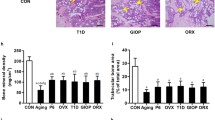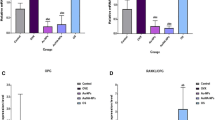Abstract
Summary
In the present study, we evaluated the potential for aminobisphosphonates to enhance the development of bone-forming osteoblasts from progenitor cells isolated from aged female osteoporotic patients. The aminobisphosphonates tested significantly enhanced osteoblast formation and thus lend further insights into their possible mode of action in the treatment of osteoporosis.
Introduction
The primary aim of this study was to evaluate the influence of aminobisphosphonates on the osteogenesis of human bone marrow stromal cells (hBMSCs) and mineralization of differentiating bone-forming cells isolated from osteoporotic patients.
Methods
The influence of aminobisphosphonate treatment on hBMSC osteogenesis was assessed by the quantitative measurement of alkaline phosphatase (ALP) activity, in addition to quantitative reverse transcription polymerase chain reaction and Western blot analysis of known osteogenic markers. Mineralized matrix formation by hBMSC-derived osteoblasts was visualized and quantified using Alizarin red staining.
Results
hBMSC cultures treated with osteogenic medium supplemented with zoledronate demonstrated a significant increase in Alizarin red staining after 3 weeks as compared to cells cultured in osteogenic medium alone. Similarly, cultures of differentiating hBMSCs isolated from patients receiving alendronate treatment also demonstrated an increased propensity for mineralization, even in the absence of further in vitro stimulation by zoledronate. The stimulatory effects of aminobisphosphonate treatment on hBMSC-derived osteoblast-mediated mineralization were independent of any alterations in ALP activity, although significant decreases in the expression levels of osteopontin (SPP1) were evident in hBMSCs following exposure to aminobisphosphonates. Further analysis including Western blotting and loss-of-function studies revealed osteopontin as having a negative influence on the mineralization of differentiating osteoporotic bone-forming cells.
Conclusions
The results presented here demonstrate for the first time that aminobisphosphonate treatment of osteoporotic hBMSCs enhances their capacity for osteoblast formation and subsequent mineral deposition, thus supporting the concept of aminobisphosphonates as having an osteoanabolic effect in osteoporosis.





Similar content being viewed by others
References
Zaidi M (2007) Skeletal remodeling in health and disease. Nat Med 13:791–801
Raggatt LJ, Partridge NC (2010) Cellular and molecular mechanisms of bone remodeling. J Biol Chem 285:25103–25108
Rodríguez JP, Garat S, Gajardo H, Pino AM, Seitz G (1999) Abnormal osteogenesis in osteoporotic patients is reflected by altered mesenchymal stem cells dynamics. J Cell Biochem 75:414–423
Rodríguez JP, Montecinos L, Rios S, Reyes P, Martinez J (2000) Mesenchymal stem cells from osteoporotic patients produce a type I collagen-deficient extracellular matrix favoring adipogenic differentiation. J Cell Biochem 79:557–565
Hess R, Pino AM, Ríos S, Fernández M, Rodríguez JP (2005) High affinity leptin receptors are present in human mesenchymal stem cells (MSCs) derived from control and osteoporotic donors. J Cell Biochem 94:50–57
Perrini S, Natalicchio A, Laviola L et al (2008) Abnormalities of insulin-like growth factor-I signaling and impaired cell proliferation in osteoblasts from subjects with osteoporosis. Endocrinology 149:1302–1313
Zhang ZM, Jiang LS, Jiang SD, Dai LY (2009) Osteogenic potential and responsiveness to leptin of mesenchymal stem cells between postmenopausal women with osteoarthritis and osteoporosis. J Orthop Res 27:1067–1073
Dalle Carbonare L, Valenti MT, Zanatta M, Donatelli L, Lo Cascio V (2009) Circulating mesenchymal stem cells with abnormal osteogenic differentiation in patients with osteoporosis. Arthritis Rheum 60:3356–3365
Egermann M, Heil P, Tami A, Ito K, Janicki P, Von Rechenberg B, Hofstetter W, Richards PJ (2010) Influence of defective bone marrow osteogenesis on fracture repair in an experimental model of senile osteoporosis. J Orthop Res 28:798–804
Jilka RL, Weinstein RS, Takahashi K, Parfitt AM, Manolagas SC (1996) Linkage of decreased bone mass with impaired osteoblastogenesis in a murine model of accelerated senescence. J Clin Invest 97:1732–1740
Silva MJ, Brodt MD, Ko M, Abu-Amer Y (2005) Impaired Marrow osteogenesis is associated with reduced endocortical bone formation but does not impair periosteal bone formation in long bones of SAMP6 mice. J Bone Miner Res 20:419–427
Kuro-o M, Matsumura Y, Aizawa H et al (1997) Mutation of the mouse klotho gene leads to a syndrome resembling aging. Nature 390:45–51
Kawaguchi H, Manabe N, Miyaura C, Chikuda H, Nakamura K, Kuro-o M (1999) Independent impairment of osteoblast and osteoclast differentiation in klotho mouse exhibiting low- turnover osteopenia. J Clin Invest 104:229–237
Bonyadi M, Waldman SD, Liu D, Aubin JE, Grynpas MD, Stanford WL (2003) Mesenchymal progenitor self-renewal deficiency leads to age-dependent osteoporosis in Sca-1/Ly-6A null mice. Proc Natl Acad Sci U S A 100:5840–5845
Choi Y, Wright AC, Johnson FB (2008) Defects in telomere maintenance molecules impair osteoblast differentiation and promote osteoporosis. Aging Cell 7:23–31
Rachner TD, Khosla S, Hofbauer LC (2011) Osteoporosis: now and the future. Lancet 377:1276–1287
Li B, Ling Chau JF, Wang X, Leong WF (2011) Bisphosphonates, specific inhibitors of osteoclast function and a class of drugs for osteoporosis therapy. J Cell Biochem 112:1229–1242
Giuliani N, Pedrazzoni M, Negri G, Passeri G, Impicciatore M, Girasole G (1998) Bisphosphonates stimulate formation of osteoblast precursors and mineralized nodules in murine and human bone marrow cultures in vitro and promote early osteoblastogenesis in young and aged mice in vivo. Bone 22:455–461
von Knoch F, Jaquiery C, Kowalsky M et al (2005) Effects of bisphosphonates on proliferation and osteoblast differentiation of human bone marrow stromal cells. Biomaterials 26:6941–6949
Duque G, Rivas D (2007) Alendronate has an anabolic effect on bone through the differentiation of mesenchymal stem cells. J Bone Miner Res 22:1603–1611
Ebert R, Zeck S, Krug R et al (2009) Pulse treatment with zoledronic acid causes sustained commitment of bone marrow derived mesenchymal stem cells for osteogenic differentiation. Bone 44:858–864
Wang C-Z, Chen S-M, Chen C-H et al (2010) The effect of the local delivery of alendronate on human adipose-derived stem cell-based bone regeneration. Biomaterials 31:8674–8683
Benisch P, Schilling T, Klein-Hitpass L et al (2012) The transcriptional profile of mesenchymal stem cell populations in primary osteoporosis is distinct and shows overexpression of osteogenic inhibitors. PLoS One 7:e45142
Wolfe M, Pochampally R, Swaney W, Reger RL (2008) Isolation and culture of bone marrow-derived human multipotent stromal cells (hMSCs). Methods Mol Biol 449:3–25
Tiaden AN, Breiden M, Mirsaidi A, Weber FA, Bahrenberg G, Glanz S, Cinelli P, Ehrmann M, Richards PJ (2012) Human serine protease HTRA1 positively regulates osteogenesis of human bone marrow-derived mesenchymal stem cells and mineralization of differentiating bone-forming cells through the modulation of extracellular matrix protein. Stem Cells 30:2271–2282
Boonen S, Laan RF, Barton IP, Watts NB (2005) Effect of osteoporosis treatments on risk of non-vertebral fractures: review and meta-analysis of intention-to-treat studies. Osteoporos Int 16:1291–1298
Eastell R, Walsh JS, Watts NB, Siris E (2011) Bisphosphonates for postmenopausal osteoporosis. Bone 49:82–88
Russell RGG (2011) Bisphosphonates: the first 40 years. Bone 49:2–19
Flanagan AM, Chambers TJ (1989) Dichloromethylenebisphosphonate (Cl2MBP) inhibits bone resorption through injury to osteoclasts that resorb Cl2MBP-coated bone. Bone Miner 6:33–43
Hughes DE, Wright KR, Uy HL, Sasaki A, Yoneda T, Roodman GD, Mundy GR, Boyce BF (1995) Bisphosphonates promote apoptosis in murine osteoclasts in vitro and in vivo. J Bone Miner Res 10:1478–1487
Breuil V, Cosman F, Stein L, Horbert W, Nieves J, Shen V, Lindsay R, Dempster DW (1998) Human osteoclast formation and activity in vitro: effects of alendronate. J Bone Miner Res 13:1721–1729
Hughes DE, McDonald BR, Russell RGG, Gowen M (1989) Inhibition of osteoclast-like cell formation by bisphosphonates in long-term culture of human bone marrow. J Clin Invest 83:1930–1935
Rogers MJ, Crockett JC, Coxon FP, Mönkkönen J (2011) Biochemical and molecular mechanisms of action of bisphosphonates. Bone 49:34–41
Plotkin LI, Bivi N, Bellido T (2011) A bisphosphonate that does not affect osteoclasts prevents osteoblast and osteocyte apoptosis and the loss of bone strength induced by glucocorticoids in mice. Bone 49:122–127
Plotkin LI, Weinstein RS, Parfitt AM, Roberson PK, Manolagas SC, Bellido T (1999) Prevention of osteocyte and osteoblast apoptosis by bisphosphonates and calcitonin. J Clin Invest 104:1363–1374
Reinholz GG, Getz B, Pederson L, Sanders ES, Subramaniam M, Ingle JN, Spelsberg TC (2000) Bisphosphonates directly regulate cell proliferation, differentiation, and gene expression in human osteoblasts. Cancer Res 60:6001–6007
Im G-I, Qureshi SA, Kenney J, Rubash HE, Shanbhag AS (2004) Osteoblast proliferation and maturation by bisphosphonates. Biomaterials 25:4105–4115
Pittenger MF, Mackay AM, Beck SC, Jaiswal RK, Douglas R, Mosca JD, Moorman MA, Simonetti DW, Craig S, Marshak DR (1999) Multilineage potential of adult human mesenchymal stem cells. Science 284:143–147
Seeman E, Delmas PD (2006) Bone quality—the material and structural basis of bone strength and fragility. N Engl J Med 354:2250–2261
Bone HG, Hosking D, Devogelaer JP, Tucci JR, Emkey RD, Tonino RP, Rodriguez-Portales JA, Downs RW, Gupta J, Santora AC, Liberman UA (2004) Alendronate Phase III Osteoporosis Treatment Study Group. Ten years’ experience with alendronate for osteoporosis in postmenopausal women. N Engl J Med 350:1189–1199
Diab DL, Watts NB (2012) Bisphosphonates in the treatment of osteoporosis. Endocrinol Metab Clin North Am 41:487–506
Thompson RN, Phillips JR, McCauley SH, Elliott JR, Moran CG (2012) Atypical femoral fractures and bisphosphonate treatment: experience in two large United Kingdom teaching hospitals. J Bone Joint Surg Br 94:385–390
Odvina CV, Levy S, Rao S, Zerwekh JE, Rao DS (2010) Unusual mid-shaft fractures during long-term bisphosphonate therapy. Clin Endocrinol (Oxf) 72:161–168
Shane E, Burr D, Ebeling PR et al (2010) Atypical subtrochanteric and diaphyseal femoral fractures: report of a task force of the American Society for Bone and Mineral Research. J Bone Miner Res 25:2267–2294
Kwek EB, Goh SK, Koh JS, Png MA, Howe TS (2008) An emerging pattern of subtrochanteric stress fractures: a long-term complication of alendronate therapy? Injury 39:224–231
Golub EE, Boesze-Battaglia K (2007) The role of alkaline phosphatase in mineralization. Curr Opin Orthop 18:444–448
Kellinsalmi M, Mönkkönen H, Mönkkönen J, Leskelä HV, Parikka V, Hämäläinen M, Lehenkari P (2005) In vitro comparison of clodronate, pamidronate and zoledronic acid effects on rat osteoclasts and human stem cell-derived osteoblasts. Basic Clin Pharmacol Toxicol 97:382–391
Giuliani N, Girasole G, Pedrazzoni M, Passeri G, Gatti C, Passeri M (1995) Alendronate stimulates b-FGF production and mineralized nodule formation in human osteoblastic cells and osteoblastogenesis in human bone marrow cultures. J Bone Miner Res 10:S171
Boskey AL, Spevak L, Paschalis E, Doty SB, McKee MD (2002) Osteopontin deficiency increases mineral content and mineral crystallinity in mouse bone. Calcif Tissue Int 71:145–154
Harmey D, Johnson KA, Zelken J, Camacho NP, Hoylaerts MF, Noda M, Terkeltaub R, Millán JL (2006) Elevated skeletal osteopontin levels contribute to the hypophosphatasia phenotype in Akp2(−/−) mice. J Bone Miner Res 21:1377–1386
Addison WN, Azari F, Sørensen ES, Kaartinen MT, McKee MD (2007) Pyrophosphate inhibits mineralization of osteoblast cultures by binding to mineral, up-regulating osteopontin, and inhibiting alkaline phosphatase activity. J Biol Chem 282:15872–15883
Acknowledgments
This study was supported by funding received from the Mäxi/CABMM Start-up grant, AOTrauma, Novartis Foundation, formerly Ciba-Geigy-Jubilee-Foundation, and Uniscientia. The authors would like to express their gratitude to Novartis (Vienna, Austria) for supplying the zoledronate used in this study.
Conflicts of interest
None.
Author information
Authors and Affiliations
Corresponding author
Additional information
R. A. Lindtner and A. N. Tiaden contributed equally to this study.
Rights and permissions
About this article
Cite this article
Lindtner, R.A., Tiaden, A.N., Genelin, K. et al. Osteoanabolic effect of alendronate and zoledronate on bone marrow stromal cells (BMSCs) isolated from aged female osteoporotic patients and its implications for their mode of action in the treatment of age-related bone loss. Osteoporos Int 25, 1151–1161 (2014). https://doi.org/10.1007/s00198-013-2494-3
Received:
Accepted:
Published:
Issue Date:
DOI: https://doi.org/10.1007/s00198-013-2494-3




